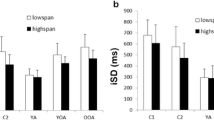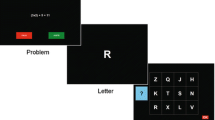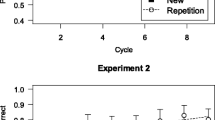Abstract
The purpose of this article is to present a behavioral theory of performance in the simple (classic) memory span experiment. This experiment has been used to investigate hypothetical mental and neurological processes and intelligent function, but behavioral span theory takes the standpoint of event-based constructs. Established empirical limits on memory span are described in terms of span ability, namely, the ability to function under span load. Span load is a count of the number of discriminative stimuli that function concurrently to occasion responding. Span ability is assessed via standard memory span procedures. The theory distinguishes response string from response chain on the basis of the locus of stimulus control; the response string is controlled by the multiple stimuli in a stimulus string or stimulus complex. Response chains are emitted intraverbals. There is no known limit to the length of a chain that can be attained through extensive experiential history, but the memory span experiment assesses the length of response strings that are severely limited at around 7 items (the span limit) and are quite resistant to change. Span limits increase during the developmental period and covary with intelligent function. The values of span ability and span load are potent tools for the prediction and control of developmental and individual differences in diverse experimental paradigms drawn from both behavior analytic and general experimental traditions.

Similar content being viewed by others
References
Ackerman, P. L., Beier, M. E., & Boyle, M. O. (2005). Working memory and intelligence: The same or different constructs? Psychological Bulletin, 131, 30–60. doi:10.1037/0033-2909.131.1.30.
Asch, S. E. (1968). The doctrinal tyranny of associationism: Or what is wrong with rote learning. In T. R. Dixon & D. L. Horton (Eds.), Verbal behavior and general behavior theory (pp. 214–228). Englewood Cliffs, NJ: Prentice-Hall.
Atkinson, R. C., & Shiffrin, R. M. (1968). Human memory: A proposed system and its control processes. In K. W. Spence & J. T. Spence (Eds.), The psychology of learning and motivation: Advances in research and theory (Vol. 2, pp. 89–195). New York: Academic Press.
Bachelder, B. L. (1970). The memory span paradigm: Its use for the analysis of mental retardation. (Unpublished doctoral dissertation). Michigan State University, East Lansing, MI.
Bachelder, B. L., & Denny, M. R. (1977a). A theory of intelligence: I. Span and the complexity of stimulus control. Intelligence, 1, 127–150. doi:10.1016/0160-2896(77)90001-0.
Bachelder, B. L., & Denny, M. R. (1977b). A theory of intelligence: II. The role of span in a variety of intellectual tasks. Intelligence, 1, 237–256. doi:10.1016/0160-2896(77)90008-3.
Baddeley, A. D. (1976). The psychology of memory. New York, NY: Basic Books.
Bartlett, F. C. (1932). Remembering: A study in experimental and social psychology. London, England: Cambridge University Press.
Bijou, S. W. (1966). A functional analysis of retarded development. International Review of Research in Mental Retardation, 1, 1–19. doi:10.1016/S0074-7750(08)60159-7.
Binet, A., & Simon, T. (1916). The development of intelligence in children (The Binet-Simon Scale) (E. S. Kite, Trans.). Baltimore, MD: Williams & Wilkins. (Original work published 1905)
Blankenship, A. B. (1938). Memory span: A review of the literature. Psychological Bulletin, 35, 1–25.
Bolton, T. L. (1892). The growth of memory in school children. American Journal of Psychology, 4, 362–380.
Boswell, S. L., Sanders, B., & Young, S. J. (1972). The effects of exposure duration and practice on the immediate memory spans of children and adults. Journal of Experimental Child Psychology, 17, 167–176.
Broadbent, D. E. (1958). Perception and communication. New York, NY: Pergamon.
Brown, J. (1958). Some tests of the decay theory of immediate memory. Quarterly Journal of Experimental Psychology, 10, 12–21.
Chase, W. G., & Ericsson, K. A. (1982). Skill and working memory. In G. H. Bower (Ed.), The psychology of learning and motivation (Vol. 16, pp. 1–58). New York: Academic Press.
Conway, A. R. A., Cowan, N., Bunting, M. F., Therriault, D. J., & Minkoff, S. R. B. (2002). A latent variable analysis of working memory capacity, short-term memory capacity, processing speed, and general fluid intelligence. Intelligence, 30, 163–184. doi:10.1016/S0160-2896(01)00096-4.
Conway, A. R. A., & Engle, R. W. (1996). Individual differences in working memory capacity: More evidence for a general capacity theory. Memory, 4, 577–590.
Conway, A. R. A., Kane, M. J., Bunting, M. F., Hambrick, D. Z., Wilhelm, O., & Engle, R. W. (2005). Working memory span tasks: A methodological review and user’s guide. Psychonomic Bulletin and Review, 12, 769–786.
Cowan, N. (2001). The magical number 4 in short-term memory: A reconsideration of mental storage capacity. Behavioral and Brain Sciences, 24, 87–185. doi:10.1017/S0140525X01003922.
Cowan, N. (2010). The magical mystery four: How is working memory capacity limited, and why? Psychological Science, 19, 51–57. doi:10.1177/0963721409359277.
Crowder, R. G. (1982). The demise of short-term memory. Acta Psychologica, 5, 291–323.
Crowder, R. G. (1993). Short-term memory: where do we stand? Memory & Cognition, 21, 142–145.
Davelaar, E. J., Goshen-Gottstein, Y., Ashkenazi, A., Haarmann, H. J., & Usher, M. (2005). The demise of short-term memory revisited: Empirical and computational investigations of recency effects. Psychological Review, 112, 3–42. doi:10.1037/0033-295X.112.1.3.
Delprato, D. J. (1986). Response patterns. In H. W. Reese & L. J. Parrott (Eds.), Behavior science: Philosophical, methodological, and empirical advances (pp. 61–113). Hillsdale, NJ: Erlbaum.
Dempster, F. N. (1981). Memory span: sources of individual and developmental differences. Psychological Bulletin, 89, 63–100. doi:10.1037/0033-2909.89.1.63.
Dixon, T. R., & Horton, D. L. (Eds.). (1968). Verbal behavior and general behavior theory. Englewood Cliffs, NJ: Prentice-Hall.
Ebbinghaus, H. (1885/1964). Memory: A contribution to experimental psychology. New York, NY: Teachers College, Columbia University.
Engle, R. W., Tuholski, S. W., Laughlin, J. E., & Conway, A. R. A. (1999). Working memory, short-term memory, and general fluid intelligence: A latent-variable approach. Journal of Experimental Psychology: General, 128, 309–331.
Ericsson, K. A., & Chase, W. G. (1982). Exceptional memory. American Scientist, 70, 607–615.
Estes, W. K. (1974). Learning theory and intelligence. American Psychologist, 29, 740–749. doi:10.1037/h0037458.
Galton, F. (1887). Supplementary notes on “prehension” in idiots. Mind, 12, 79–82.
Gertner, J. (2012). The idea factory: Bell Labs and the great age of American innovation. New York, NY: Penguin.
Gignac, G. E. (2015). The magical numbers 7 and 4 are resistant to the Flynn effect: No evidence for increases in forward or backward recall across 85 years of data. Intelligence, 48, 85–95. doi:10.1016/j.intell.2014.11.001.
Gignac, G. E., & Weiss, L. G. (2015). Digit span is (mostly) related linearly to general intelligence: Every extra bit of span counts. Psychological Assessment, 27, 1312–1323. doi:10.1037/pas0000105.
Gray, S., Green, S., Alt, M., Hogan, T., Kuo, T., Brinkley, S., & Cowan, N. (2017). The structure of working memory in children and its relation to intelligence. Journal of Memory and Language, 92, 183–201. doi:10.1016/j.jml.2016.06.004.
Guilford, J. P., & Dallenbach, K. M. (1925). The determination of memory span by the method of constant stimuli. American Journal of Psychology, 36, 621–628. doi:10.2307/1413916.
Holmes, O. W. (1871). Mechanism in thought and morals. Boston, MA: James R. Osgood.
Humphreys, L. G. (1994). Intelligence from the standpoint of a (pragmatic) behaviorist. Psychological Inquiry, 5, 179–192. doi:10.1207/s15327965pli0503_1.
Jacobs, J. (1887). Experiments on “prehension.”. Mind, 12, 75–79.
Jensen, A. R. (1970). A theory of primary and secondary familial mental retardation. In N. R. Ellis (Ed.), International review of research in mental (pp. 33–105). New York, NY: Academic Press.
Kantor, J. R. (1924). Principles of psychology (Vol. 1). New York, NY: Alfred A. Knopf.
Kantor, J. R. (1959). Interbehavioral psychology. Granville, OH: Principia Press.
Lyon, D. R. (1977). Individual differences in immediate serial recall: a matter of mnemonics? Cognitive Psychology, 9, 403–411.
Mahadevan, R., Malone, J. C., & Bailey, J. (2002). Radical behaviorism and exceptional memory phenomena. Behavior and Philosophy, 30, 1–13.
Melton, A. W. (1963). Implications of short-term memory for a general theory of memory. Journal of Verbal Learning and Verbal Behavior, 2, 1–21.
Michael, J., Palmer, D. C., & Sundberg, M. L. (2011). The multiple control of verbal behavior. Analysis of Verbal Behavior, 27, 3–22.
Miller, G. A. (1956). The magical number seven, plus or minus two: some limits on our capacity for processing information. Psychological Review, 63, 81–97.
Neath, I., & Surprenant, A. M. (2003). Human memory (2nd ed.). Belmont, CA: Wadsworth.
Peterson, L. R., & Peterson, M. J. (1959). Short-term retention of individual verbal items. Journal of Experimental Psychology, 58, 193–198.
Ryan, J. J., Lopez, S. J., & Paolo, A. M. (1996). Digit span performance of persons 75–96 years of age: Base rates and associations with selected demographic variables. Psychological Assessment, 8, 324–327. doi:10.1037/1040-3590.8.3.324.
Skinner, B. F. (1938). The behavior of organisms. New York, NY: Appleton-Century-Crofts.
Skinner, B. F. (1957). Verbal behavior. New York, NY: Appleton-Century-Crofts.
Staats, A. W. (1996). Behavior and personality: Psychological behaviorism. New York, NY: Springer.
Takahashi, M., Shimizu, H., Saito, S., & Tomoyori, H. (2006). One percent ability and ninety-nine percent perspiration: A study of a Japanese memorist. Journal of Experimental Psychology: Learning, Memory, and Cognition, 32, 1195–1200. doi:10.1037/0278-7393.32.5.1195.
Tillman, C. M. (2011). Developmental change in the relation between simple and complex spans: A meta-analysis. Developmental Psychology, 47, 1012–1025. doi:10.1037/a0021794.
Unsworth, N., & Engel, R. W. (2007). The nature of individual differences in working memory capacity: Active maintenance in primary memory and controlled search from secondary memory. Psychological Review, 114, 104–132. doi:10.1037/0033-295X.114.1.104.
Winch, W. H. (1904). Immediate memory in school children. British Journal of Psychology, 1, 127–134.
Woods, D. L., Herron, T. J., Yund, E. W., Hink, R. F., Kishiyama, M. M., & Reed, B. (2011). Computerized analysis of error patterns in digit span recall. Journal of Clinical and Experimental Neuropsychology, 33, 721–734. doi:10.1080/13803395.2010.550602.
Author information
Authors and Affiliations
Corresponding author
Ethics declarations
Funding
Preparation of the manuscript was self-funded.
Conflict of Interest
There is no conflict of interest.
Ethical Approval
All span testing procedures were in accordance with the ethical standards of the institutional research committees and with the 1964 Helsinki declaration and its later amendments. Informed consent was obtained for all children and adults and participation was always voluntary.
Additional information
The final version of this paper was prepared by Dennis J. Delprato after Dr. Bachelder’s death.
Rights and permissions
About this article
Cite this article
Bachelder, B.L., Delprato, D.J. The Simple Memory Span Experiment: A Behavioral Analysis. Psychol Rec 67, 423–433 (2017). https://doi.org/10.1007/s40732-017-0222-7
Published:
Issue Date:
DOI: https://doi.org/10.1007/s40732-017-0222-7




